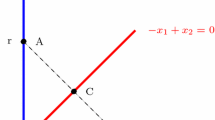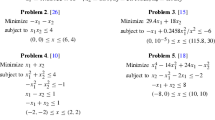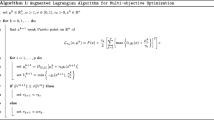Abstract
It is well-known that the Lagrangian dual of an Integer Linear Program (ILP) provides the same bound as a continuous relaxation involving the convex hull of all the optimal solutions of the Lagrangian relaxation. It is less often realized that this equivalence is effective, in that basically all known algorithms for solving the Lagrangian dual either naturally compute an (approximate) optimal solution of the “convexified relaxation”, or can be modified to do so. After recalling these results we elaborate on the importance of the availability of primal information produced by the Lagrangian dual within both exact and approximate approaches to the original (ILP), using three optimization problems with different structure to illustrate some of the main points.
Similar content being viewed by others
References
Bacaud, L., C. Lemaréchal, A. Renaud, and C. Sagastizábal. (2001). “Bundle Methods in Stochastic Optimal Power Management: A Disaggregated Approach Using Preconditioners.” Computational Optimization and Applications 20, 227–244.
Bahiense, L., N. Maculan, and C. Sagastizábal. (2002). “The Volume Algorithm Revisited: Relation with Bundle Methods.” Math. Prog. 94(1), 41–70.
Balakrishnan, A., T.L. Magnanti, and R.T. Wong. (1989). “A Decomposition Algorithm for Local Access Telecommunications Network Expansion Planning.” Op. Res. 37, 716–740.
Balakrishnan, A., T.L. Magnanti, and R.T. Wong. (1995). “A Dual-Ascent Procedure for Large-Scale Uncapacitated Network Design.” Op. Res. 43(1), 58–76.
Barahona, F. and R. Anbil. (2000). “The Volume Algorithm: Producing Primal Solutions with a Subgradient Method.” Math. Prog. 87(3), 385–400.
Barnhart, C. and Y. Sheffi. (1993). “Dual-Ascent Methods for Large-Scale Multi-Commodity Flow Problems.” Naval Research Logistics 40, 305–324.
Barnhart, C., C.A. Hane, and P. Vance. (1998). “Using Branch-and-Price-and-Cut to Solve Origin-Destination Integer Multicommodity Flow Problems.” Op. Res. 32(3), 208–220.
Benders, J.F. (1962). “Partitioning Procedures for Solving Mixed Variables Programming Problems.” Numerische Mathematik 4, 238–252.
Ben Amor, H. (2002). “Stabilisation de l'Algoritme de Génération de Colonnes.” Ph.D. Thesis. GERAD, Université de Montréal, Montreal, QC, Canada.
Borghetti, A., A. Frangioni, F. Lacalandra, and C.A. Nucci. (2002). “Lagrangian Heuristics Based on Disaggregated Bundle Methods for Hydrothermal Unit Commitment.” IEEE Transactions on Power Systems 18, 313–323.
Camerini, P.M., L. Fratta, and F. Maffioli. (1975). “On Improving Relaxation Methods by Modified Gradient Techniques.” Math. Prog. Study 3, 26–34.
Cappanera, P., G. Gallo, and F. Maffioli. (2003). “Discrete Facility Location and Routing of Obnoxious Activities.” Disc. Appl. Math. 133, 3–28.
Castro, J. (2000). “A Specialized Interior-Point Algorithm for Multicommodity Network Flows.” SIAM J. on Opt. 10, 852–877.
Carraresi, P., L. Girardi, and M. Nonato. (1995). “Network Models, Lagrangian Relaxations and Subgradient Bundle Approach in Crew Scheduling Problems.” In J. Paixao (ed.), Computer Aided Scheduling of Public Transport, Lecture Notes in Economical and Mathematical Systems, Springer-Verlag.
Chang, S.-G. and B. Gavish. (1995). “Lower Bounding Procedures for Multiperiod Telecommunications Network Expansion Problems.” Op. Res. 43(1), 43–57.
Crainic, T.G., A. Frangioni, and B. Gendron. (2001). “Bundle-Based Relaxation Methods for Multicommodity Capacitated Fixed Charge Network Design Problems.” Discrete Appl. Math. 112, 73– 99.
Dantzig, G.B. and P. Wolfe. (1960). “The Decomposition Principle for Linear Programs.” Op. Res. 8, 101–111.
Dentcheva, D., A. Prékopa, and A. Ruszczynski. (2002). “Bounds for Integer Stochastic Programs with Probabilistic Constraints.” Discrete Appl. Math. 124, 55–65.
Deza, M.M. and M. Laurent. (1997). Geometry of Cuts and Metrics. Algorithms and Combinatorics 15, Springer-Verlag, Heidelberg.
du Merle, O., J.-L. Goffin, and J.-P. Vial. (1998). “On Improvements to the Analytic Center Cutting Plane Method.” Computational Optimization and Applications 11, 37–52.
Farwolden, J.M. and W.B. Powell. (1994). “Subgradient Methods for the Service Network Design Problem.” Trans. Sci. 28(3), 256-272.
Frangioni, A. (1996). “Solving Semidefinite Quadratic Problems within Nonsmooth Optimization Algorithms.” Comput. & Oper. Res. 23, 1099–1118.
Frangioni, A. (2002). “Generalized Bundle Methods.” SIAM J. on Opt. 13(1), 117–156.
Frangioni, A. and G. Gallo. “A Bundle Type Dual-Ascent Approach to Linear Multicommodity Min Cost Flow Problems.” INFORMS J. on Comp. 11(4), 370–393.
Frangioni, A., A. Lodi, and G. Rinaldi. (2005). “Lagrangian Approaches for Optimizing over the Semimetric Polytope.” Math. Prog. (to appear).
Fréville, A., M. Guignard, and S. Zhu. (1999). “Column generation and Lagrangean Relaxation: Two Powerful Related Tools for Integer Programming.” OPIM Department Report 99–12–22, The Wharton School, U. of Pennsylvania.
Fuduli, A. and M. Gaudioso. (2000). “Fixed and Virtual Stability Center Methods for Convex Nonsmooth Minimization.” In G. Di Pillo and F. Giannessi (eds.), Nonlinear Optimization and Applications 2, Kluwer Academic Publishers, pp. 105–122.
Gavish, B. (1985). “Augmented Lagrangian Based Algorithms for Centralized Network Design.” IEEE Trans. on Communications 33, 1247–1257.
Geoffrion, A.M. (1974). “Lagrangian Relaxation and its Uses in Integer Programming.” Math. Prog. Study 2, 82–114.
Goffin, J.-L., J. Gondzio, R. Sarkissian, and J.-P. Vial. (1997). “Solving Nonlinear Multicommodity Flow Problems by the Analytic Center Cutting Plane Method.” Math. Prog. 76, 131–154.
Gouveia, L. (1995). “A 2n Constraint Formulation for the Capacitated Minimal Spanning Tree Problem.” Op. Res. 43, 130–141.
Grigoriadis, M.D. and L.G. Kahchiyan. (1995). “An exponential-Function Reduction Method for Block-Angular Convex Programs.” Networks 26, 59–68.
Guignard, M. and S. Kim. (1987). “Lagrangian Decomposition: A Model Yelding Stronger Lagrangian Bounds.” Math. Prog. 39, 215–228.
Guignard, M. (1998). “Efficient Cuts in Lagrangean 'Relax-and-Cut' Schemes.” EJOR 105, 216–223.
Guignard, M. (2003). “Lagrangean Relaxation.” TOP 11(2), 151–228.
Guignard, M. and M.B. Rosenwein. (1989). “An Application-Oriented Guide for Designing Lagrangian Dual Ascent Algorithms.” EJOR 43, 197–205.
Held, M. and R. Carp. (1971). “The Travelling Salesman Problem and Minimum Spanning Trees: Part II.” Math. Prog. 1, 6–25.
Held, M., P. Wolfe, and H.P. Crowder. (1974). “Validation of Subgradient Optimization.” Math. Prog. 6, 62–88.
Hiriart-Urruty, J.-B. and C. Lemaréchal. (1993). Convex Analysis and Minimization Algorithms II—Advanced Theory and Bundle Methods. Grundlehren Math. Wiss. 306, New York: Springer-Verlag.
Jones, K.L., I.J. Lustig, J.M. Farwolden, and W.B. Powell. (1993). “Multicommodity Network Flows: The Impact of Formulation on Decomposition.” Math. Prog. 62, 95–117.
Kiwiel, K. (1999). “A Bundle Bregman Proximal Method for Convex Nondifferentiable Optimization.” Math. Prog. 85, 241–258.
Kelley, J.E. (1960). “The Cutting-Plane Method for Solving Convex Programs.” Journal of the SIAM 8, 703–712.
Larsson, T., M. Patriksson, and A.-B. Strömberg. (1999). “Ergodic, Primal Convergence in Dual Subgradient Schemes for Convex Programming.” Math. Prog. 86, 283–312.
Lemaréchal, C. (2001). Lagrangian Relaxation. In M. Jünger and D. Naddef (eds.), Computational Combinatorial Optimization, Springer Verlag, Heidelberg, pp. 115–160.
Lemaréchal, C., A. Nemirovskii, and Y. Nesterov. (1995). “New variants of bundle methods.” Math. Prog. 69, 111–147.
Lemaréchal, C. and A. Renaud. (2001). “A Geometric Study of Duality Gaps, with Applications.” Math. Prog. 90, 399–427.
Lomonosov, M.V. (1985). “Combinatorial Approaches to Multiflow Problems.” Discrete Appl. Math. 11(1), 1–93.
McBride, R.D. (1998). “Advances in Solving the Multicommodity Flow Problem.” SIAM J. on Opt. 8, 947–955.
Nesterov, Y. (1995). “Complexity Estimates of Some Cutting Plane Methods Based on the Analytic Barrier.” Math. Prog. 69, 149–176.
Padberg, M.W. and G. Rinaldi. (1991). “A Branch-and-Cut Algorithm for the Resolution of Large-Scale Symmetric Travelling Salesman Problems.” SIAM Rev. 33, 60–100.
Pinar, M.C. and S.A. Zenios. (1994). “On Smoothing Exact Penalty Functions for Convex Constrained Optimization.” SIAM J. on Opt. 4, 486–511.
Poljak, B.T. (1977). “Subgradient Methods: A Survey of Soviet Research.” In C. Lemaréchal and R. Mifflin (eds.), Nonsmooth Optimization, IIASA Proceedings Series vol. 3, Pergamon Press.
Schultz, R. (2003). “Stochastic Programming with Integer Variables.” Math. Prog. 97, 285–309.
Takriti, S. and J.R. Birge. (2000). “Lagrangean Solution Techniques and Bounds for Loosely Coupled Mixed Integer Stochastic Programs.” Op. Res. 48, 91–98.
Vazirani, V.V. (2001). Approximation Algorithms. New York: Springer-Verlag.
Zhao, X. and P.B. Luh. (2002). “New Bundle Methods for Solving Lagrangian Relaxation Dual Problems.” JOTA 113(2), 373–397.
Zhuang, F. and F.D. Galiana. (1988). “Towards a More Rigorous and Practical Unit Commitment by Lagrangian Relaxation.” IEEE Transactions on Power Systems 3, 763–773.
Author information
Authors and Affiliations
Corresponding author
Rights and permissions
About this article
Cite this article
Frangioni, A. About Lagrangian Methods in Integer Optimization. Ann Oper Res 139, 163–193 (2005). https://doi.org/10.1007/s10479-005-3447-9
Issue Date:
DOI: https://doi.org/10.1007/s10479-005-3447-9




